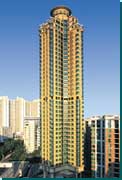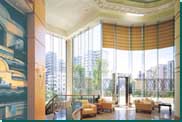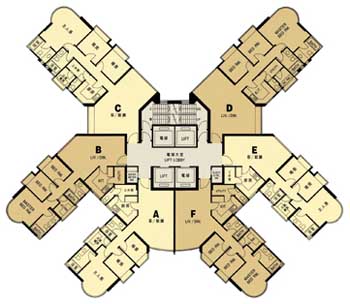| October
2000 |
 |
|
|
Ellery Court, Ho Man Tin
A crown over Kowloon
Adversity makes man wise
and, judging by the design of Ellery Court, certainly makes architects
creative.
 Located
on a hillside in Ho Man Tin, Ellery Court is the second phase of
a luxury residential project developed by China Overseas Building
& Development. The project is unusual in that it is closely
surrounded by existing, albeit low-rise, developments and has only
one narrow street frontage. LPT Architects director Agnes Ng explained
that, due to this constraint, the building was placed in the middle
of the 2,627 sq m site, rather than set to one side, to obtain enough
light to meet Buildings Department guidelines. Located
on a hillside in Ho Man Tin, Ellery Court is the second phase of
a luxury residential project developed by China Overseas Building
& Development. The project is unusual in that it is closely
surrounded by existing, albeit low-rise, developments and has only
one narrow street frontage. LPT Architects director Agnes Ng explained
that, due to this constraint, the building was placed in the middle
of the 2,627 sq m site, rather than set to one side, to obtain enough
light to meet Buildings Department guidelines.
The project is situated
in front of Dragon View, the first-phase residential tower which
was completed in 1998. One consideration being the need to avoid
blocking this building's
view as far as possible, the architect came up with a 33-storey-high
tower sitting on a transfer plate supported on 16 soaring columns.
This design has two advantages: it opens up the view for its sister
and pushes up the building's
height to capture the seaview to the south.
A sculptural approach
was adopted for the vast open space thus created beneath the tower.
Some of the columns, exposed, stand directly in an irregularly shaped
swimming pool which is half covered and half exposed. A jacuzzi
occupying the rest of the space is covered by the tower eight metres
above high tinted glass panels. Making up for the lack of street
frontage, this space, which stands two to three floors above street
level, provides the project with visibility and drama, especially
at night when the lit swimming pool throws shimmering light onto
the structure.
The 983 sq m clubhouse
is spread over two levels below the double-volume space and contains
a gym, children's play area,
golf simulator and table tennis room. Below the clubhouse is a 47-space
car park accessed via the main entrance on Level 3, where the only
street frontage is located. A separate pedestrian entrance is provided
10 m below the vehicular entrance, where the client has given the
development right of way over land he also owns.
The main lobby is a double-volume,
circular space covered in the warm tones of light yellow and brown
and decorated by a view of the water feature outside. According
to Ms Ng, the architect wanted to dress up the public space to project
a sense of warmth and elegance without making it look like a hotel.
This is achieved by the use of soft, mainly uplighting, warm colours
and decorative elements reminiscent of the Art Deco movement.
One example of such elements
is a fibreglass relief which resembles a stylised peacock. According
to Ms Ng, local artists were commissioned to develop the basic design
for the relief, which was produced in Shenzhen and then sent back
to Hong Kong for touching-up. This relief becomes a motif of the
project; it recurs on every floor, and doubles as a directional
sign incorporating the floor number in its design.
Another Art Deco-inspired
decoration is a painting in the clubhouse which resembles the machine
age paintings of that period.
The building has 186
units arranged on a cruciform plan designed to accommodate six flats
per floor. In order to maximise the view, the structural wall is
shifted to the side to make way for curved windows in the master
bedroom. At the same time, to make the most of the seaview, the
floor plans above the refuge floor are shifted to ensure that the
curved windows in flats commanding the view look out on Tsim Sha
Tsui. The use of laminated glass reduces the need for mullions and
double-glazing is provided to insulate the apartments from noise
generated by the busy Princess Margaret Road.
Echoing the design of
the public space inside the building as well as the facade treatment
of the first-phase development, the building has an exterior of
a slightly darker yellow, which is similar to but not the same as
the colour scheme of the other building. This yellow, however, is
not solid -- to give the exterior a softer, more subtle touch, the
architect has composed it with three colours, with the yellow interspersed
with bands of white and brown to generate a visual change of colour
grade.
The flats in this building
enjoy generous headrooms -- 3.1 m for the lower floors and 3.5 m
for the upper floors. In addition to a sense of space and comfort,
the tall headrooms are also a means of pushing up the building's
height, to better capture the view.
Ellery Court contains
four duplexes and two triplexes at the top. The duplexes were designed
with the entrance at the upper level. Direct access to the terrace
and the roof is provided for the private quarters at the lower level.
The configuration of the triplexes is just the opposite: the flat
roof is attached to the first floor, where the lounge and games
room are located. A spacious master bedroom complete with private
jacuzzi and attached terrace occupy the middle floor and more bedrooms
are placed in the top floor.
The terraces are marked
by fins on columns which, according to Ms Ng, are designed to enhance
the sculptural quality of the building as well as to make the open
space more inviting and less frightening, given the height.
Above the triplexes and
duplexes, the roof of the building is crowned by a round tower surrounded
by an arcade of double columns. Ms Ng said this feature was designed
to make an architectural statement and to increase the prominence
of the building. It also serves a functional purpose: it both houses
and masks a satellite dish.

28th to 43rd floor plan
Unlike the typical angular
cruciform block, this building is full of curves and irregular shapes
designed to increase its sculptural quality. This is also enhanced
by the design of an external lighting scheme, for which the architect
engaged the expertise of a specialist consultant.
Although height restriction
in the area has been relaxed following the relocation of the airport,
Ellery Court is expected to remain the tallest building in Ho Man
Tin for some years due to its favourable position on a hill. With
the curved windows lit like strips of neon set against the flicker
of deeper windows as well as the uplights and floodlights of the
exterior, this building is set to glow like a beacon on the Kowloon
peninsula, a distinctive presence in the night sky.
architect LPT Architects
Ltd
project manager China Overseas Property Ltd
structural engineer CM Wong & Associates Ltd
m&e engineer Felix Tsang & Partners
quantity surveyor Frank & Vargeson (HK) Ltd
main contractor China Overseas Building Construction Ltd
|

 Located
on a hillside in Ho Man Tin, Ellery Court is the second phase of
a luxury residential project developed by China Overseas Building
& Development. The project is unusual in that it is closely
surrounded by existing, albeit low-rise, developments and has only
one narrow street frontage. LPT Architects director Agnes Ng explained
that, due to this constraint, the building was placed in the middle
of the 2,627 sq m site, rather than set to one side, to obtain enough
light to meet Buildings Department guidelines.
Located
on a hillside in Ho Man Tin, Ellery Court is the second phase of
a luxury residential project developed by China Overseas Building
& Development. The project is unusual in that it is closely
surrounded by existing, albeit low-rise, developments and has only
one narrow street frontage. LPT Architects director Agnes Ng explained
that, due to this constraint, the building was placed in the middle
of the 2,627 sq m site, rather than set to one side, to obtain enough
light to meet Buildings Department guidelines.